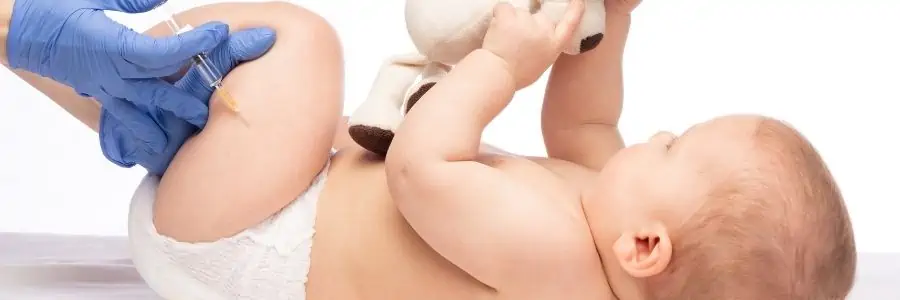
Childhood Vaccinations: Over 10 types of vaccines to keep your child safe
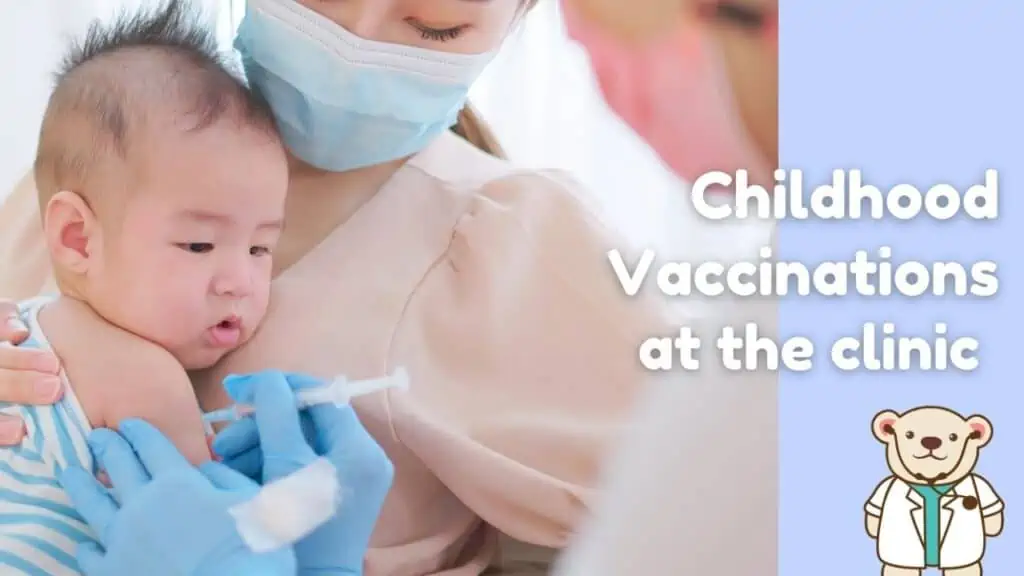
As some parents may already know, childhood vaccinations play an important role in protecting children from deadly diseases and in keeping the child safe from developing severe reactions to other dangerous diseases.
The Malaysian government has outlined all the types of vaccines recommended in the national immunization schedule. This vaccine schedule, officially referred to as the National Immunization Program (NIP), is provided free of charge in all Ministry of Health facilities throughout Malaysia.
On top of that, parents are also recommended to get their children immunized with vaccines that are not listed in the National Immunization Program, which can be provided at private hospitals or clinics.
At FirstStep Child Specialist Clinic, we are able to provide most of the childhood vaccinations listed in the National Immunization Program as well as the additional vaccines, as shown in the table below.
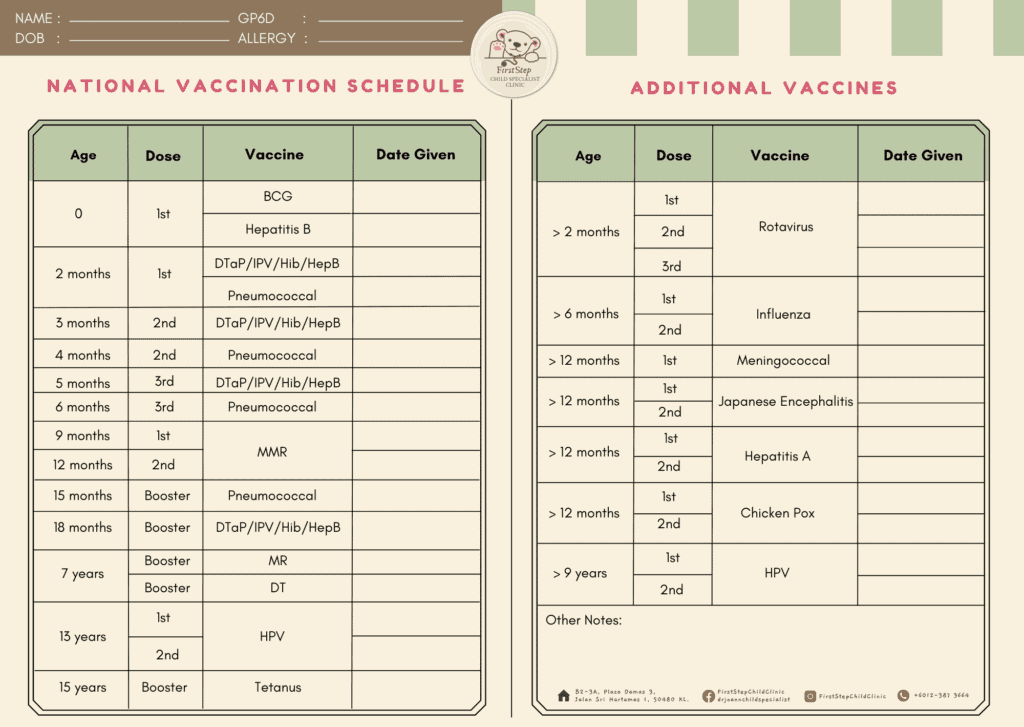
Looking at all the types of childhood vaccinations and calculating the time period that your child should be getting the vaccine can be quite overwhelming for parents, but don’t worry too much, as your paediatrician can help to answer any concerns and address any confusion you may have regarding childhood vaccinations. In addition, the nurses and assistants at the clinic will usually follow-up with reminders about any vaccines that your child is due to receive.
Read on further to find out all about the different types of childhood vaccinations.
Contents:
- Firstly, what is a vaccine made up of?
- Why should my child get vaccinations for diseases that are no longer prevalent?
- Is it safe for my baby to get more than 1 vaccine at a time?
- What are the different types of childhood vaccines?
- Recommended childhood vaccines for newborns (0 months)
- Recommended Childhood Vaccinations for infants (2-6 months)
- Recommended Childhood Vaccinations for babies (9-12 months)
- Additional Childhood Vaccinations
- What if I have just moved from a different country?
- As a parent, what should I expect at a vaccination appointment?
- References
Firstly, what is a vaccine made up of?

A vaccine is a dead, or a weakened version, or a part of the germ that causes a particular disease. Exposure to the disease via the vaccine will prompt the body’s immune system to build up antibodies that protect the child from contracting the disease if they are exposed to the actual disease in the future.
Evidently, there has been some controversy surrounding childhood vaccinations and their effect on the child’s mental and physical development. However, there has been no significant findings that point to the vaccines causing any harm to children. All childhood vaccinations have been tested and approved by the ministry, so they are safe for children to take.
Why should my child get vaccinations for diseases that are no longer prevalent?
Some diseases, such as polio and mumps, are not as easily contracted as they were in the past, however, it is still important for your child to be vaccinated against them, as unfortunately, the diseases still may be widespread in other parts of the world. Seeing how globalized the world has now become, it is best to be protected against these diseases, as they can be spread by travelers.
Is it safe for my baby to get more than 1 vaccine at a time?
Sometimes, your baby may be due for more than 1 vaccine at a time. If you’re worried about any potential side effects, you can talk to the paediatrician about spreading the appointments out. However, it is very common for children to get 1 to 3 vaccines at once, without any harmful effects. The amount of virus/bacteria in the vaccine is so small that it is not enough to harm the child. In fact, what could be more harmful is delaying a child’s vaccine appointment without reason.
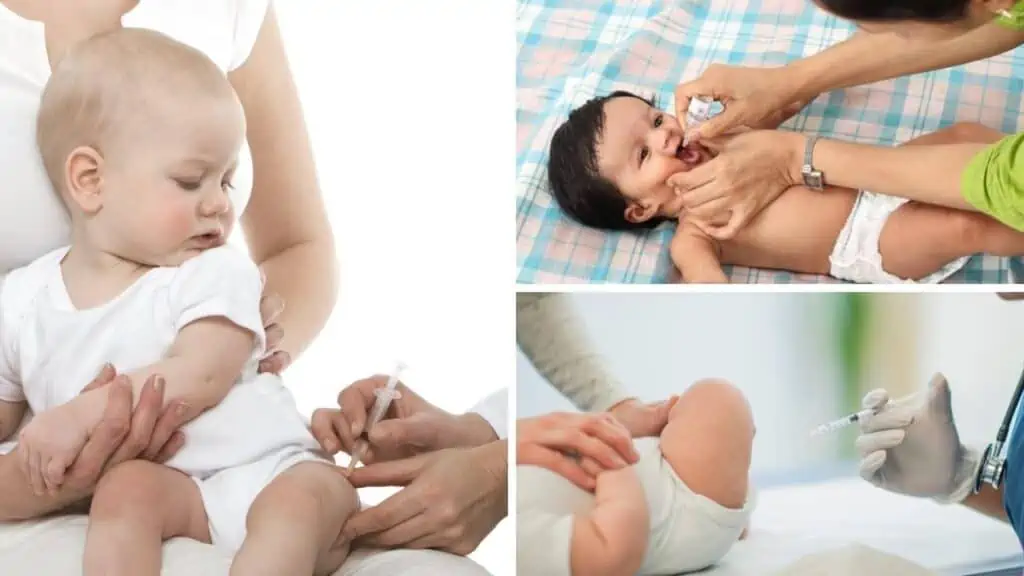
What are the different types of childhood vaccines?
Recommended childhood vaccines for newborns (0 months)
- BCG
- Hepatitis B
1. Bacillus Calmette – Guerin (BCG) 💉
The BCG vaccine would usually be administered as soon as the baby is born. It is one of the most common childhood vaccines and is administered to most babies worldwide. It is often injected into the child’s upper arm.
The BCG vaccine contains a weakened strain of the TB (tuberculosis) bacteria, which works to give protection against severe forms of childhood TB, such as TB meningitis.
🩹 Common side effects:
- soreness at the injection site
- high temperature (fever)
- headache
- swollen glands under armpit / swollen lymph nodes
- vomiting
Oftentimes, a raised blister will develop at the injection site, which may fill with pus, before bursting and then leaving a small scar. Therefore, after receiving the vaccine it is important to ensure that the area of the injection site is left uncovered as exposure to air will aid in its healing process. Additionally, it would be best not to apply any ointments as the blister is forming and healing.
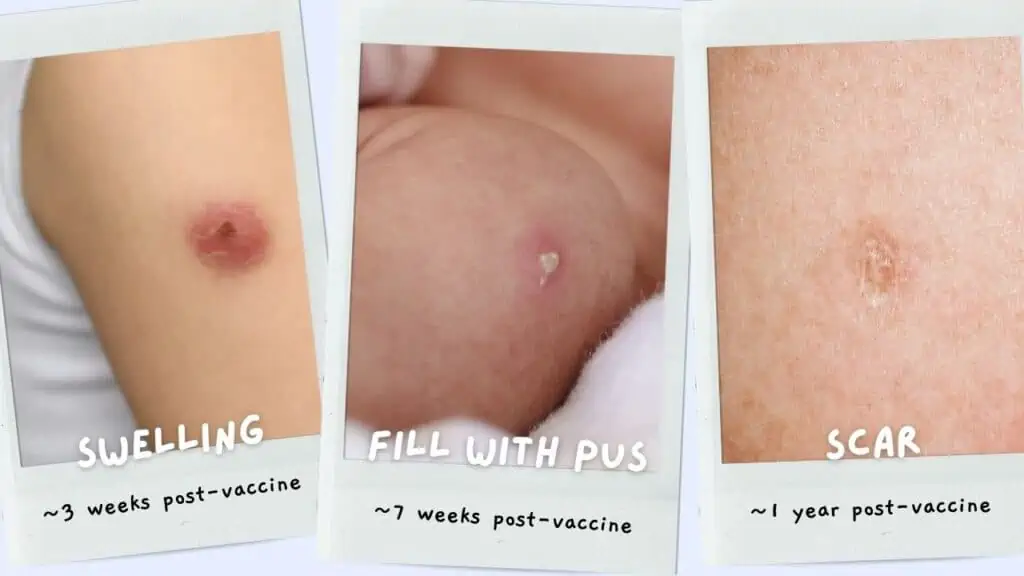
2. Hepatitis B 💉
Another childhood vaccine given right after birth is the Hepatitis B vaccine, usually given in the upper arm or at the thigh.
This vaccine protects against illnesses brought upon by the Hepatitis B virus. Some illnesses caused by this virus have very mild symptoms, but in some cases, the virus can cause high fever, nausea, or vomiting.
The hepatitis B vaccine provides long-term immunity against the virus. The vaccine also plays a significant role in decreasing the risk of developing liver cancer.
This childhood vaccination is spread out in 3 doses: one right after birth, another at 2 months old, and the third dose at 5 months old. A booster dose is also recommended, which would usually be given at 18 months.
🩹 Common side effects:
- swelling at the site of injection
- diarrhea
- loss of appetite
- fussiness / crying / clingy
- low-grade fever
- runny nose
Recommended Childhood Vaccinations for infants (2-6 months)
- 6-in-1 vaccine
- Pneumococcal
1. 6-in-1 vaccine 💉
As its name suggests, the 6-in-1 vaccine helps to protect children from 6 dangerous childhood diseases:
- Diphtheria (bacterial infection of the throat or skin)
- Hepatitis B
- Pertussis (whooping cough)
- Haemophilus Influenza Type B [Hib Disease] (bacterial infection leading to meningitis, pneumonia, blood infections)
- Polio (viral disease causing muscle weakness / paralysis)
- Tetanus (bacterial infection affecting the central nervous system)
The vaccine is also referred to as the DTap/IPV/Hib/Hep B vaccine. It is usually administered in 3 doses (at 2 months, 3 months and 5 months old), with an additional booster dose at 18 months. With every injection, the child’s immune system grows stronger.
Typically, the vaccine would be given on the thigh.
At FirstStep Child Specialist Clinic, we offer the vaccine under the brand name ‘Hexaxim’ or ‘Infanrix Hexa’.
🩹 Common side effects:
- tenderness / swelling / pain at site of injection
- irritability
- fever
- vomiting
- weakness / lethargy

2. Pneumococcal Vaccine 💉
This vaccine protects against illnesses brought upon by the Streptococcus pneumoniae bacteria, which can lead to pneumonia, meningitis as well as infections of the ears, lungs, blood and brain.
The vaccine is given in 3 doses (given at 2 months, 4 months and 6 months) and a booster dose at 15 months.
At our clinic, we can usually offer 2 types of the pneumococcal vaccine:
i. Synflorix (PCV-10) – protects against 10 types of pneumococcal bacteria
ii. Prevenar 13 (PCV13) – protects against the same types of pneumococcal bacteria as Synflorix, plus 3 additional ones
The vaccine that would be administered to the child will depend on the paediatrician’s assesment.
🩹 Common side effects:
- irritability
- swelling / soreness at the site of injection
- low appetite
- fever
Recommended Childhood Vaccinations for babies (9-12 months)
MMR 💉
MMR is a childhood vaccination that works to protect against measles, mumps and rubella (german measles). The vaccine provides effective protection against complications caused by these diseases, and for most people, it provides lifetime immunity. In some cases, the immunity may decrease later in life, but if an individual is found to be at risk of contracting the illness, a booster dose can be given.
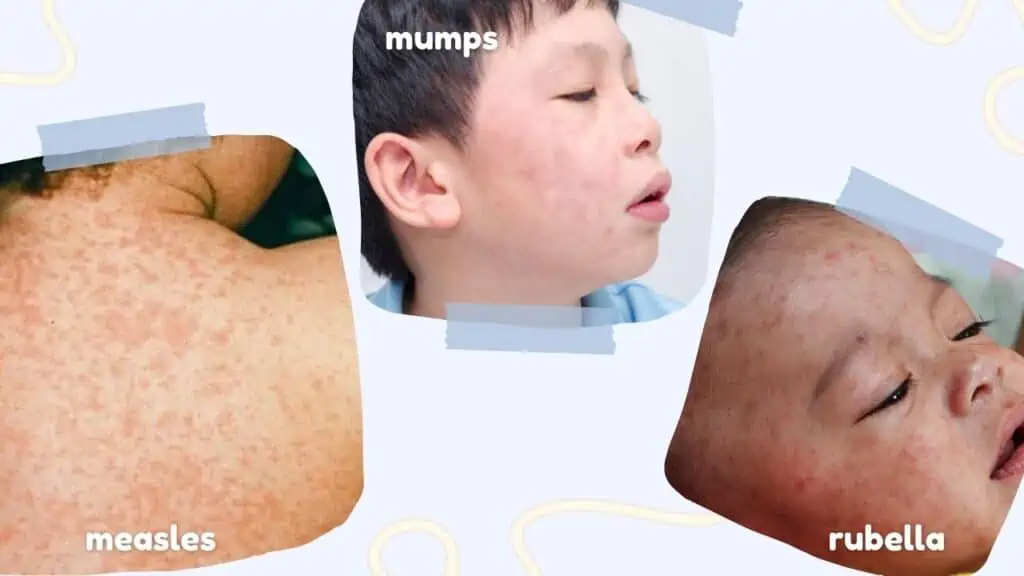
The vaccine would usually be given in 2 doses, the first at 9 months, and the second dose at 12 months old.
🩹 Common side effects:
- swelling / soreness / redness at the site of injection
- fever (which develops about 7-11 days after the injection)
Additional Childhood Vaccinations
On top of the vaccines listed above, it is also recommended to take the additional vaccines listed below, for added protection against other potentially life-threatening diseases.
What are the additional childhood vaccinations?
- Rotavirus
- Influenza
- Meningococcal
- Japanese Encephalitis
- Hepatitis A
- Chicken Pox
- HPV
Rotavirus 💉
This vaccine protects against the rotavirus, which can cause severe diarrhea, vomiting and fever. Children exposed to the virus can become severely dehydrated and may need hospital admission.
There are 2 types of rotavirus vaccines that can be offered at the clinic. Unlike most other vaccines, the rotavirus vaccine is an oral vaccine, meaning that it is given by feeding drops of the vaccine in the child’s mouth.
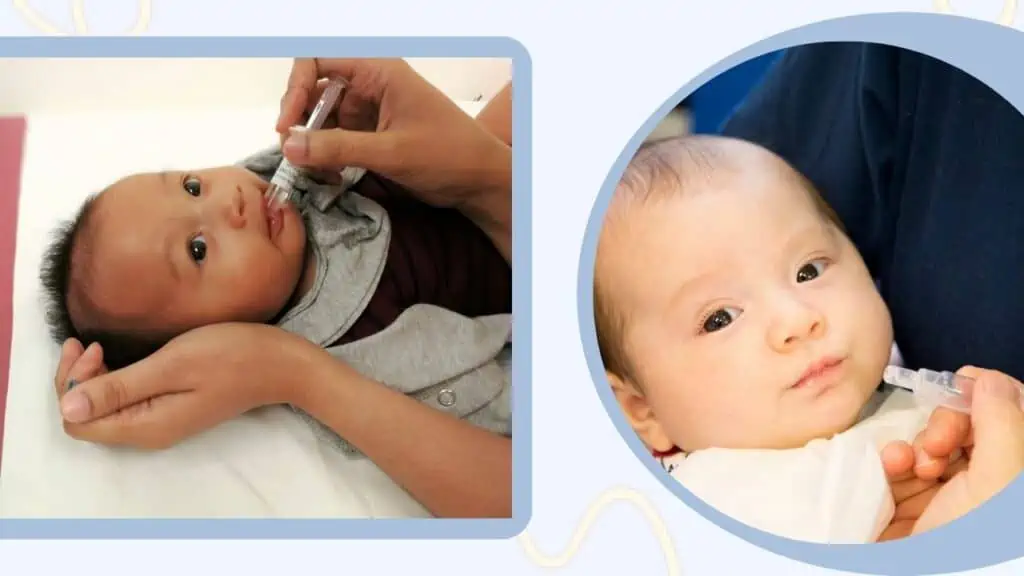
At our clinic, we can offer 2 brands of the vaccine:
- RotaTeq – administered in 3 doses (2 months, 4 months, 6 months)
- Rotarix – administered in 2 doses (2 months and 4 months)
An important thing to note is that the first dose of the rotavirus vaccine should be given before the child is 15 weeks old, as most older children have probably already had a rotavirus infection, which lessens the effect of the vaccine.
🩹 Common side effects:
- diarrhea
- vomiting
- irritability
Influenza 💉
A popular childhood vaccination is the influenza vaccine.
Receiving the influenza vaccine will give the child’s body the opportunity to form antibodies that protect it from the flu. The flu vaccine can be given to children 6 months and above.
Children younger than 9 years old getting the flu shot for the first time will usually receive 2 doses, at least 1 month apart. After that, they will only require 1 annual dose.
Children older than 9 years old will usually only need 1 dose.
The influenza vaccine is modified and reformulated annually, as viruses keep evolving into new strains, which is why it is recommended to get an annual dose of the vaccine.
Our clinic provides 2 types of the vaccine:
- Fluarix Tetra
- Vaxigrip Tetra
Both vaccines provides immunization against 4 strains of influenza virus.
🩹 Common side effects:
- soreness / swelling at the site of injection
- fever
- nausea
- muscle aches
Meningococcal 💉
This vaccine, usually given as a single dose after 12 months of age, protects the child from strains of meningococcal bacteria that could lead to meningitis or septicemia (blood infection).
At our clinic, we offer the vaccine under the brand ‘Nimenrix’
🩹 Common side effects:
- loss of appetite
- irritability
- fever
- swelling / pain / redness at the site of injection
Japanese Encephalitis (JE) 💉
This vaccine is most commonly administered in Sarawak, but can also be given in other parts of Malaysia. It is given to protect children against the JE virus, which is transmitted to humans from animals. The virus can cause affected individuals to develop serious symptoms and complications, such as inflammation of the lining of the brain, seizures and paralysis.

According to the NIP, the vaccine is given as 2 doses, at 9 and 21 months old.
The JE vaccine given at our clinic is under the brand name ‘Imojev’.
🩹 Common side effects:
- redness / pain at the site of injection
- fever
- irritability
- sleepiness / tiredness
Hepatitis A 💉
The hepatitis A virus can lead to liver disease. Although symptoms may not exist in children younger than 6 years old, it can still be spread easily. The hepatitis A vaccine can help to protect against the virus and prevent an outbreak of the disease in the future.
The vaccine is recommended for children 12 months old and above, given in 2 doses.
The Hepatitis A vaccine given at our clinic is under the brand ‘Havrix 720 Junior’.
🩹 Common side effects:
- diarrhea
- drowsiness / fatigue
- nausea / vomiting
- pain / redness / swelling at site of injection
Chickenpox 💉
The chickenpox vaccine can be given to children older than 12 months old, to protect the child from chickenpox, a highly contagious childhood illness caused by a virus called the varicella-zoster. Nevertheless, vaccinated individuals may still be infected with the disease, but their symptoms tend to be less severe than non-vaccinated individuals.
The vaccine is given in 2 doses, first around 12-15 months old, and the second dose 3 months after. Teens above 13 years old may also get the vaccine if they have never received it before, with a gap of 1 month between the 2 doses.
The chickenpox vaccine brand given at our clinic is ‘Varivax’.
🩹 Common side effects:
- pain / redness / bruising at the site of injection
- fever
- sore throat, runny nose, stuffy nose
- tiredness
HPV 💉
HPV refers to the Human Papillomavirus. It is the main cause of cervical cancer, thus the HPV vaccine is usually recommended for girls. HPV immunization will help to prevent the risk of developing cervical cancer.
The vaccine will be administered in 2 doses. The first dose can be given to children aged 9 and above, and the following dose would be given 6-12 months after the first dose.
At our clinic the HPV vaccine given is under the brand ‘Gardasil’. It would usually be administered on the child’s arm.
🩹 Common side effects:
- pain / redness / swelling at the site of injection
- diziness / nausea
- fever
- muscle or joint pain
What if I have just moved from a different country?
Families that have just moved to Malaysia from overseas looking to continue their children’s immunization are more than welcome to do so at our clinic. Make sure you have a record of any childhood vaccinations that your child has already received and bring it along to the child’s vaccination appointment, so that the paediatrician can check which vaccines they are due for next.
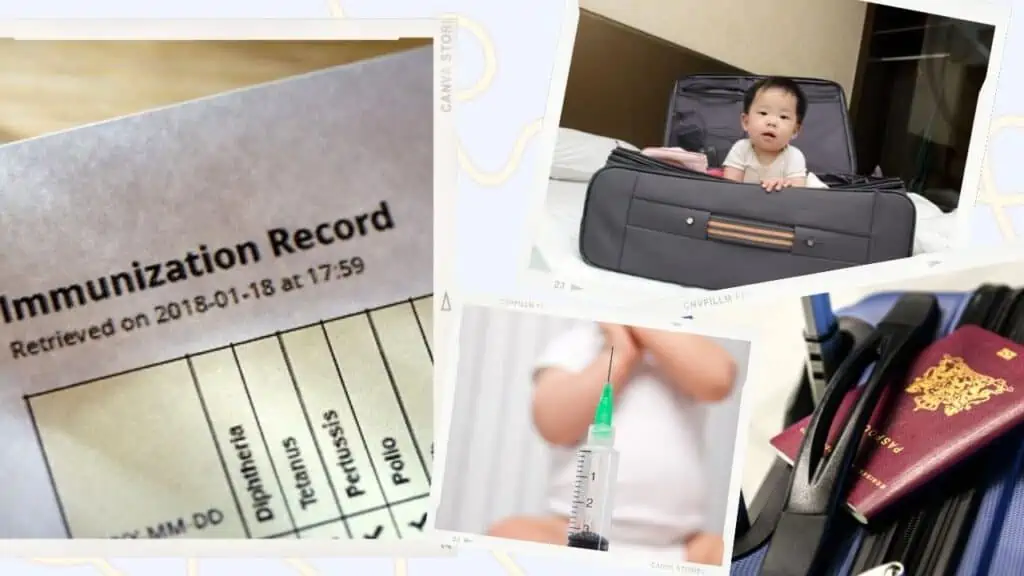
As a parent, what should I expect at a vaccination appointment?
Usually, the paediatrician will get your child’s measurements (height, weight and head circumference) and check your child’s vaccine records to ensure the child is receiving the appropriate vaccine. If you have any questions about the vaccine’s composition, side effects, or anything else you are unsure of, this would be the right time to ask the doctor.
Infants will usually be given the vaccine on their thigh. The doctor and nurses will assist you in managing the child, but if you are unsure how to hold your child during the procedure, take a look at the video below for a brief guide.
Thank you for reading our article on childhood vaccinations!
You can read our other related articles to learn more about the side effects/rare complications of vaccines or learn about the importance of vaccines in general.
References
Jasman, N. N. A. (2022). Does the vaccine effectively prevent Japanese Encephalitis Infection?. doctoroncall.com.my. https://www.doctoroncall.com.my/health-centre/vaccination/japanese-encephalitis-vaccine
NHS. (2022). Japanese Encephalitis. nhs.uk. https://www.nhs.uk/conditions/japanese-encephalitis/
NHS. (2022). MMR (measles, mumps and rubella) vaccine. nhs.uk. https://www.nhs.uk/conditions/vaccinations/mmr-vaccine/.
NHS. (2022). Rotavirus vaccine FAQs. nhs.uk. https://www.nhs.uk/conditions/vaccinations/rotavirus-vaccine-questions-answers/
The Immunisation Advisory Centre. (2017). Quick answers to frequent pneumococcal vaccine questions [Ebook] (pp. 1-2). https://www.immune.org.nz/.
World Health Organization. (2022). How are vaccines developed?. who.int. https://www.who.int/news-room/feature-stories/detail/how-are-vaccines-developed

Pingback: General Pediatrics & Outpatient Care: Find out how your pediatrician can help to care for your child - FirstStep Child Specialist Clinic
Pingback: Effective ways to manage and prevent the stomach flu - FirstStep Child Specialist Clinic